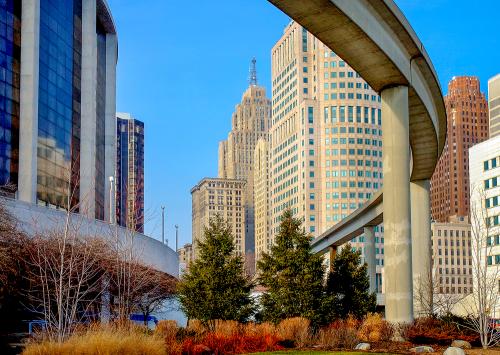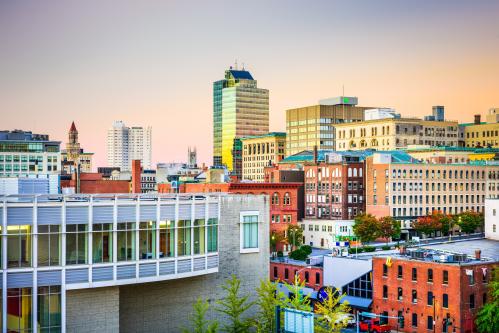In case you missed it, a video recording is available for the online event Recovery in America’s legacy cities, held on Wednesday, October 7, 2020.
For the past few weeks, protests and unrest have roiled Rochester, N.Y. following revelations of the death of a Black man, Daniel Prude, in police custody. In response, Rochester Mayor Lovely Warren forcefully acknowledged the role of structural racism, long-standing inequities, and other institutional failures that led to Prude’s death—and the need for the city and its leadership to do better. This shocking racial episode has taken place against the backdrop of a city that—like many similar places—was already struggling to recover economically from decades of population decline and rising poverty and unemployment. These are characteristics of “legacy” cities, or places with previously thriving industrial pasts that have faced long-term economic decline now compounded by the COVID-19 pandemic.
In a recent Brookings report, I identified several reasons why legacy cities like Rochester are more likely than other places to experience more severe impacts from the ongoing pandemic-fueled economic crisis. In addition to substantially weaker economic bases as well as the deep racial and spatial inequities that commonly plague these places, legacy cities have many other vulnerabilities. These include weakened municipal systems and related fiscal problems, unique economic reliance on anchor institutions (e.g., cultural, academic, medical), small business commercial corridors hobbled by COVID-19, and accelerating workplace automation that could displace large percentages of the low-income workers that populate these cities.
However, there are also reasons for optimism in legacy cities. In the wake of the Great Recession and leading up to the pandemic, many legacy cities had benefited from a redoubled commitment to core cities and neighborhoods, increased awareness that economic gains were not equally shared by race and place, and innovative public-private-civic collaborations that leveraged local dedication, leadership, and resilience.
While these interventions alone cannot compensate for decades of disinvestment and racial injustice in legacy cities, they represent promising starting points for recovery and healing. For example, in the lead-up to the COVID-19 pandemic and subsequent revelations of racial injustice, Rochester had begun to institute new mechanisms for addressing the need for shared prosperity. Recently, local public and private sector collaborations launched the Connected Communities initiative, making core neighborhood investments in the EMMA and Beechwood neighborhoods, with another pot of funds slated for Rochester’s 19th Ward, whose motto is “Urban by Choice.”
Such interventions suggest multiple ways in which public, private, and philanthropic actors are addressing long-standing challenges in many legacy cities through collaborations—creating or leveraging intermediaries, building on targeted public investments, and spearheading philanthropic initiatives.
A first set of collaborations emerge as intermediaries, filling a gap in local systems to bridge investment and need. Workforce intermediaries, for instance, help calibrate and match supply (i.e., the right number of appropriately trained workers) and demand (i.e., the vacant occupations that employers need to fill). One new workforce intermediary just getting underway is Tech Buffalo, a corporate-led program in Buffalo, N.Y. with significant state funding that aims to upskill current workers and train unemployed or underemployed community members for entry-level, tech-related occupations in a range of sectors. As a small business/ entrepreneurship intermediary, Detroit’s New Economy Initiative invests in, stewards, and monitors the nonprofits that fund and assist women- and minority-owned businesses start and grow. Community development intermediaries such as Cleveland Neighborhood Progress and Pittsburgh’s Neighborhood Allies support local organizations and assist in redistributive investment efforts among neighborhoods.
A second set of innovative interventions are precipitated by significant public investments directed at addressing acute market failures. In Rochester, the city’s Office of Community Wealth Building initiated programs focusing on minority small business investment startup and growth needs in order to increase financial inclusion and access to credit. In Buffalo, the state of New York invested in both a workforce training provider (Northland Workforce Training Center) and a high-tech incubator/magnet (43North), both of which led to investments and collaboration with corporate entities and philanthropy. Other significant public investments target specific geographic areas: Detroit’s Strategic Neighborhood Fund has channeled $130 million in investment to 10 neighborhoods, with $74 million in public dollars leveraging $57 million of combined philanthropic and corporate funding. East Side Avenues in Buffalo focused on four commercial corridors, where the state’s $65 million in capital investment attracted an additional $8 million in philanthropic investments.
A third set of collaborations emerge as large philanthropic initiatives, or multi-funder collaboratives to jump-start holistic, place-based transformation efforts. In Pontiac, Mich., one effort is investing simultaneously in entrepreneurship, small businesses, green spaces, and workforce. In Ohio, the Cincinnati Center City Development Corporation (3CDC) has invested over $1 billion in the Over-the-Rhine neighborhood. In Rochester, local philanthropies invested in commercial corridors such as Jefferson Avenue and Plymouth-Exchange, leveraging the University of Rochester’s considerable nearby presence. Rochester’s Strong National Museum of Play has also been the centerpiece of a large infrastructure and neighborhood revitalization effort, attracting investments and anchoring economic development.
These interventions aim to break long-standing downward spirals, but they can also address acute cycles of decline precipitated by events like the COVID-19 economic crisis, helping to reverse declining consumer spending, widespread small business closures, and mounting unemployment.
As these examples demonstrate, America’s legacy cities are bastions of untapped social and human capital waiting to be unleashed. As the COVID-19 crisis drags on, collaborative solutions are not just “nice-to-have” methods of stabilization and recovery; they are “must-have” methods essential to sustained prosperity in an environment where no single organization or sector can go it alone.
As the case of Rochester illustrates, the twin crises of COVID-19 and structural racism demand holistic approaches to shore up legacy cities, helping them withstand another round of layoffs, fiscal shrinkage, and small business closures. Against that backdrop, legacy cities have a window of opportunity to build on emerging and effective collaborations that can foster long-overdue, systemic improvements to their economic and social landscape.






Commentary
Amid economic and racial crises, legacy city collaborations point a path forward
September 29, 2020